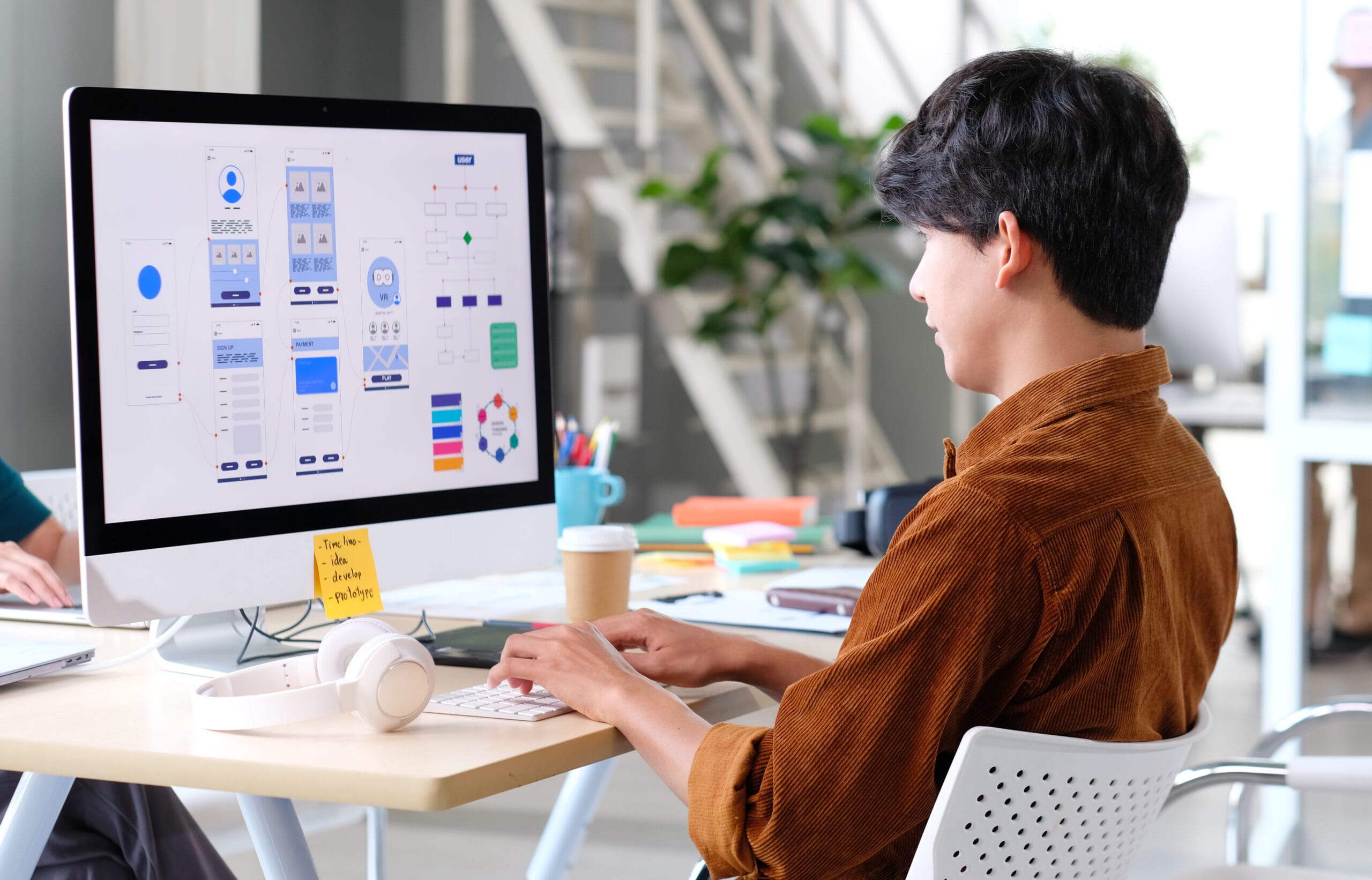How web development drives responsive and adaptive layouts
The Benefits of Effective Web Layout in Today's Digital Landscape
Reliable Web layout plays a vital duty fit the success of online businesses today. It goes beyond simple aesthetics, influencing variables like individual experience, SEO, and brand integrity. As companies seek to catch the attention of a significantly mobile target market, understanding the subtleties of Web layout becomes vital. The implications of these aspects can considerably impact conversion rates and competitive positioning in the electronic landscape. What particular advantages can reliable layout offer an organization?
Enhancing User Experience
Just how can reliable website design significantly enhance customer experience? It works as a crucial component in creating a engaging and intuitive online atmosphere. A well-structured design enables individuals to browse effortlessly, decreasing aggravation and improving complete satisfaction. Clear, concise content coupled with visually enticing graphics promotes a smooth interaction, allowing individuals to find details rapidly and effortlessly.
Additionally, responsive style warranties that websites function efficiently throughout various devices, fitting mobile individuals and improving accessibility. Quick loading times even more contribute to a positive user experience, as hold-ups can bring about boosted bounce prices. In addition, integrating user comments right into the style process helps programmers produce interfaces that satisfy the details requirements of their target market, cultivating a feeling of link and trust fund. Eventually, effective website design not only attracts individuals yet likewise keeps them, creating the structure for a successful on-line presence.

Improving Engagement and Retention
Efficient Web layout considerably influences customer engagement and retention. Aesthetic appeal, user-friendly navigating, and mobile responsiveness are vital elements that add to a favorable online experience. By prioritizing these facets, internet sites can attract visitors and urge them to return.
Visual Appeal Matters
Why is visual appeal important in website design? The visual quality of a site plays a crucial role in attracting and preserving site visitors. An aesthetically appealing style catches focus, urging individuals to check out material even more. This involvement is substantial, as individuals are most likely to hang around on sites that supply a pleasing experience. Effective visual aspects-- such as color schemes, typography, and imagery-- can convey brand name identity and worths, fostering a link with the audience. In an era where numerous web sites compete for attention, a solid visual charm can set apart a brand and boost customer perception. Eventually, the ideal style elements not only enhance interaction however additionally influence the likelihood of return visits, making visual allure an essential factor in Web design success.
Easy to use Navigation
User-friendly navigation is a keystone of effective Web design, working as the roadmap for site visitors to discover a site's web content. When individuals come across instinctive navigating, they can quickly situate information, which improves their total experience. Clear menus, logical categorization, and recognizable symbols guide customers perfectly, lowering irritation and increasing the possibility of involvement. Furthermore, a well-structured navigating system urges site visitors to spend even more time on the website, inevitably enhancing retention prices. Reliable navigation style not only help in customer satisfaction but likewise cultivates depend on in the brand, making it most likely for users to return. In an affordable electronic landscape, focusing on user-friendly navigation can substantially impact an internet site's success by enhancing user communication and commitment.
Mobile Responsiveness Significance
As the usage of smart phones proceeds to rise, the value of mobile responsiveness in website design becomes progressively clear. Internet sites that adapt seamlessly to numerous display dimensions improve customer experience, bring about enhanced engagement and retention. A receptive design guarantees that content is easily available, whether customers get on smartphones, desktop computers, or tablet computers. This flexibility not just boosts usability however additionally adds to far better search engine positions, as online search engine prioritize mobile-friendly sites. Subsequently, companies that purchase responsive Web layout can get to a wider audience and minimize bounce rates. In general, mobile responsiveness is necessary in today's electronic landscape, as it straight affects exactly how users connect with online web content and affects their general complete satisfaction.
Improving Search Engine Optimization and Exposure
Reliable Web style plays an important duty in improving seo (SEO) and total presence - branding. A well-structured web site with user-friendly navigating enables search engine spiders to index material a lot more effectively. This structure consists of maximized URLs, header tags, and a rational hierarchy, which contribute to much better positions on internet search engine results pages (SERPs)
In addition, efficient Web layout includes mobile responsiveness, guaranteeing that websites come across various gadgets. Online search engine prioritize mobile-friendly styles, impacting visibility significantly. In addition, the tactical use of search phrases within material and meta tags, integrated with a visually attractive format, draws in individual engagement and lowers bounce rates.
Developing Brand Trustworthiness
A properly designed internet site imparts trust fund and confidence in site visitors, which is necessary for establishing brand name reputation. In today's competitive digital landscape, customers are fast to judge a brand name based on its online visibility. A specialist format, user-friendly navigation, and cohesive branding components signal reliability and competence.
Moreover, top notch visuals and interesting content show a brand name's commitment to high quality, additional enhancing its credibility. Uniformity in style across various platforms cultivates experience, making individuals more probable to involve with the brand name.
In addition, incorporating testimonies, situation studies, and sector qualifications can bolster reliability by showcasing real-world endorsements and experience.

Boosting Conversion Rates
Maximizing website design directly affects conversion prices by creating a seamless customer experience that overviews visitors towards desired activities. Reliable Web design includes intuitive navigation, clear phone calls to activity, and visually enticing designs, which collectively boost customer engagement. When users locate it very easy to accessibility information and connect with the website, they are more probable to full deals or register for solutions.
Tactical placement of elements such as switches and types can noticeably affect conversion results. A/B testing of different style approaches permits companies to recognize which designs produce the greatest conversion rates. In addition, integrating count on signals, such as endorsements and safety badges, can alleviate individual worries, eventually leading to enhanced conversions. By prioritizing user-centric style concepts, websites can not just draw in site visitors however likewise convert them into loyal customers, showing the essential role of effective website design in attaining company goals.
Adapting to Mobile Users
Adapting to mobile users is necessary in modern website design, as a raising number of individuals access the internet by means of tablet computers and smartphones. Executing mobile-friendly layout concepts and a receptive design guarantees that websites feature seamlessly across various tools. This versatility not just enhances individual experience yet also adds to higher involvement and fulfillment.
Mobile-Friendly Layout Principles
As mobile phone use continues to skyrocket, carrying out mobile-friendly design concepts comes to be crucial for creating reliable Web experiences. These principles concentrate on optimizing the user interface to enhance navigation and interaction on smaller screens. Key elements include simplifying designs to avoid mess, using bigger touch targets for ease of usage, and making sure text is readable without zooming. Additionally, focusing on quickly packing times is important, as mobile users frequently depend on varying net speeds. Crucial material ought to be conveniently available, with clear phone call to action guiding users seamlessly through the website. By sticking to these principles, services can much better involve their mobile audience, ultimately improving user contentment and retention in a progressively mobile-centric globe.
Responsive Design Importance
Just how can a website successfully deal with its diverse target market? The answer lies in the implementation of a receptive layout. As mobile use remains to climb, the significance of adjusting website design to various display dimensions ends up being paramount. A responsive design assurances that content is visually appealing and easily accessible across gadgets, improving individual experience. This flexibility not only fosters user engagement yet additionally boosts internet search engine positions, as internet search engine prefer mobile-friendly sites. Additionally, a receptive design minimizes the requirement for numerous variations of a site, improving upkeep and updates. Fundamentally, accepting responsive formats is important for companies aiming to reach a more comprehensive audience and preserve a competitive side in the electronic landscape.
Staying Ahead of Rivals
Reliable website design continually plays a crucial function in assisting companies remain in advance of competitors. In an increasingly digital industry, a well-designed website can distinguish a brand name from its competitors. Firms that focus on user experience, intuitive navigating, and visually pleasing visuals not only attract even more site visitors however also increase the chance of conversions. see page A reliable Web existence mirrors professionalism and trust, imparts count on, and improves brand name reputation.
Including the most current layout trends and technologies maintains an organization appropriate. Rivals commonly fall behind if they overlook updates, making it important for business to adapt and introduce. SEO-optimized website design also ensures higher online search engine rankings, driving natural website traffic and exposure.
Ultimately, companies that invest in effective website design acquire a calculated benefit. This aggressive technique not only enhances consumer interaction but also fosters loyalty, placing the brand as a leader in its market.
Often Asked Concerns
The length of time Does It Take to Layout a Reliable Website?
Creating a reliable web site usually takes between four to twelve weeks, depending upon intricacy, customer requirements, and group experience. Extensive planning, prototyping, and modifications are important for attaining a successful final product.
What Are the Expenses Connected With Specialist Web Layout?
Costs related to expert website design differ widely, normally ranging from a few hundred to numerous thousand bucks see post (web design). Factors consist of designer experience, job intricacy, functionality demands, and ongoing upkeep, impacting total financial investment significantly
Can I Upgrade My Website Without Shedding Current Traffic?

What Tools Can I Utilize for Do It Yourself Website Design?
For DIY website design, individuals can use devices like WordPress, Wix, Squarespace, and Canva. These systems supply easy to use interfaces, adjustable themes, and different functions to produce aesthetically appealing sites without substantial coding expertise.
Just how Commonly Should I Update My Web Site Design?
It is suggested to update web site layout every 1-2 years to keep significance and use. Normal evaluations can guarantee the site continues to be visually attractive and useful, adjusting to evolving user choices and technical innovations.
Exactly how can reliable Web design significantly enhance individual experience? Efficient Web style significantly affects user involvement and retention. Reliable navigation style not just help in customer satisfaction but additionally fosters trust in the brand, making it extra most likely for individuals to return. Inevitably, a reliable Web style not only brings in visitors yet likewise cultivates a sense of reliability, urging individuals to view the brand name as authoritative and genuine in its area. Effective Web design integrates user-friendly navigating, clear telephone calls to action, and aesthetically appealing layouts, which jointly improve user engagement.